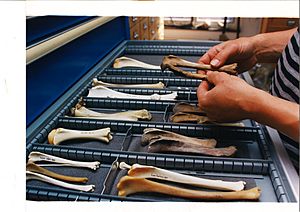Archaeozoology facts for kids
Archaeozoology is a cool science that studies animals from the past. It's like being a detective, but instead of solving crimes, archaeozoologists solve mysteries about how animals lived long ago. They look at animal remains found at old human sites. These remains are usually bones and teeth. Sometimes, they even find hair, skin, or other body parts!
Archaeozoology also explores how animals affected the environment. Plus, it helps us understand the special connections between humans and animals throughout history. The people who do this exciting work are called archaeozoologists. They often train as either biologists, who study living things, or archaeologists, who study human history through digging up old objects.
Contents
What Do Archaeozoologists Study?
Archaeozoologists mainly study the physical remains of animals. These remains are often found during archaeological digs. They can tell us a lot about ancient life.
Bones and Teeth: The Main Clues
The most common animal remains found are bones and teeth. These parts are very strong and can last for thousands of years. By studying them, scientists can figure out:
- What type of animal it was (like a deer, a fish, or a bird).
- How old the animal was when it died.
- If the animal was healthy or had diseases.
- What the animal ate.
- If humans hunted or raised the animal.
Other Amazing Finds
Sometimes, archaeozoologists get lucky and find other parts of animals. These might include:
- Shells from snails or clams.
- Fish scales.
- Insect parts.
- Even preserved hair or skin, especially in very dry or cold places.
These rare finds give even more details about ancient animals and their lives.
Why is Archaeozoology Important?
This science helps us understand the past in many ways. It connects animals, humans, and the environment.
Understanding Past Environments
Animals are a big part of any ecosystem. By studying ancient animal remains, archaeozoologists can learn about:
- What the climate was like long ago. For example, finding bones of animals that prefer cold weather might mean the area was colder.
- What kind of plants grew in an area. The types of animals present can tell us about the vegetation they ate.
- How landscapes changed over time.
Human-Animal Relationships Through History
Humans and animals have always lived together. Archaeozoology helps us see how this relationship changed:
- Hunting: Did ancient people hunt wild animals for food or tools? What animals did they hunt most?
- Domestication: When and where did humans start taming animals like dogs, sheep, or cows? How did this change human societies?
- Diet: What did ancient people eat? Animal bones can show if they ate a lot of meat, fish, or other animal products.
- Trade: Were animals or animal products traded between different groups of people?
- Culture: Did animals play a role in ancient art, religion, or ceremonies?
How Do Archaeozoologists Work?
Archaeozoologists use special methods to study animal remains.
Excavation and Recovery
First, animal bones are carefully dug up at archaeological sites. This is called excavation. It's important to record exactly where each bone is found. This helps understand the context of the discovery.
Lab Work and Analysis
Once in the lab, the bones are cleaned and identified. Scientists compare them to modern animal skeletons to figure out the species. They use microscopes and other tools to look for signs of butchery, disease, or wear. They might also use advanced techniques like DNA analysis to learn even more.
Related pages
Images for kids
See also
 In Spanish: Zooarqueología para niños
In Spanish: Zooarqueología para niños




